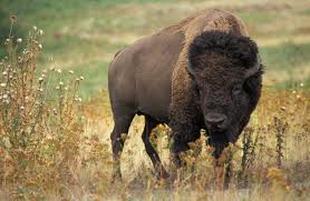|
If preventing the spread of Brucellosis by bison herds is the primary concern by Yellowstone officials, have they considered an inoculation program for all bison calves?
Dairy herds in the United States are required to be Certified Brucellosis-Free and are tested yearly. Infected cows are killed. Young dairy stocks are vaccinated to reduce the chance of transmission of the disease. Proof of vaccination is tattooed on the calf’s ear with the birth year. Wild bison and elk in the Greater Yellowstone region are the last remaining reservoir for Brucellosis in the US; therefore, an aggressive vaccination program to target the young could be initiated and prevent the senseless slaughter and preserve two of the great indigenous wild species in America. Limiting factors could be cost, access to the young calves, and feasibility for long term success. Still, it’s something to think about. Native Americans gather in protest In anticipation of the yearly cull, Native American activists gathered in Montana's capital as early as last February to protest the deaths of hundreds of Yellowstone National Park bison to be killed this year to ease the worries of Montana ranchers about a cattle disease carried by park buffalo. The demonstration marked a week of protests over federal-state management of Yellowstone bison that entails culling the herd each winter when some animals cross from the park into neighboring Montana in search of food, according to a report in Reuters. "This is a new beginning to protect the bison and other wildlife in Indian country," Jimmy St. Goddard, a self-described spiritual leader of the Blackfeet Tribe in Montana, said in a telephone interview from outside the Montana Capitol in Helena to Reuters. As of February 2015, 300 bison had already been sent for slaughter. Rick Wallen, lead wildlife biologist for Yellowstone's bison program, said in a statement at the time that cutting bison numbers was required to accommodate concerns expressed by surrounding states and “that they really didn’t want wild bison outside the national park.” Pros and Cons of Culling National Geographic tackled the pros and cons of culling animals in a story in 2014. “What's driving these high-profile culling programs? Are they necessary? Can they be done ethically? And what's at the heart of the debate between their proponents and their detractors?” They recognized that culling practices are driven by the loss of open spaces. Wild herds like the bison are confined to human configured boundaries, which they call “gigantic zoos.” Federal preserves like Yellowstone are, indeed spaces for animals, but also for spectators from all over the world who visit Yellowstone anticipating a glimpse at our nation’s indigenous buffalo. Before the advent of modern civilization, nature was the culler of wildlife species, and still is to some extent. “If an animal becomes superabundant in a limited habitat, they're going to have either a die-off from starvation or some pathogen that will take advantage of their vulnerabilities. Then there's hunting by predators, including humans,” they wrote. Animals can be brought back from the brink of extinction like the Canada geese and the white-tailed deer; but similar to humans, animals can become victims of their own success and become so abundant that they then become a threat to the survival of other species and to their own populations. Still, can we say culling is a sign of the success of the conservation movement or political acquiescence to cattle ranchers? Is there such a thing as an ethical kill? A report from the United Kingdom mentioned in the National Geographic article decried the inhumane killing of badgers. Animal ethicists consider the avoidance of suffering to be primary, rather than the avoidance of death. For example, killing an animal with a sharpshooter is better than torturing the animal in a “protracted and disruptive capture” causing unnecessary fear and pain. Contact should be minimal and humane. Any culling or capture program should be with evidence-based rationale for removal, “not wishful thinking.” Any program should anticipate risks and make the goal disease reduction or achieve sustainable and monitored populations. Putting the desires of ranchers aside, there are two distinct ethical philosophies: the people committed to wildlife conservation and animal rights advocates. Many times they are at loggerheads because animal rights’ groups believe every animal should have the right to live, and conservation practices, including culling, consider the preservation of ecosystems not only the individual animal. There are no definitive conclusions in this report. Modern civilization has created artificial habitats, and they must be managed or lose biodiversity as well as wildlife populations. For me, it’s not so important that we condemn culling or capture programs, but more important how the programs are planned and implemented. For bison, have all alternative avenues for controlling Brucellosis been explored like vaccinating calves? Are cattle ranchers more concerned with Brucellosis infection or bison grazing on cattle land—land that might be leased federal land in some cases. Is it possible an aggressive vaccination program might eventually eradicate Brucellosis? There are no easy answers to any of these questions, and scientific and ethical inquiry are valued for oversight of disease reduction and preservation of wildlife populations. Additional resources Reuters Guardian
5 Comments
Eileen
21/11/2015 04:47:29 pm
Thanks Dava for an interesting report as always
Reply
Dava Castillo
22/11/2015 12:10:17 am
Thank you for reading and commenting Eileen.
Reply
Eileen
22/11/2015 12:58:51 am
Until we cull people I cannot see culling animals as an option except in very rare cases maybe :)
B. McPherson
23/11/2015 05:23:03 pm
In Canada there are an increasing number of bison farms -- for meat. The meat is very tasty and lean and expensive. Never an easy call when we are trying to juggle the wild's rights against our own.
Reply
Dava Castillo
24/11/2015 07:32:10 pm
Thank you for reading and commenting Barbara.
Reply
Leave a Reply. |
Dava Castillo
is retired and lives in Clearlake, California. She has three grown
children and one grandson and a Bachelor’s degree in Health Services
Administration from St. Mary’s College in Moraga California. On the
home front Dava enjoys time with her family, reading, gardening, cooking
and sewing. Archives
November 2015
|


